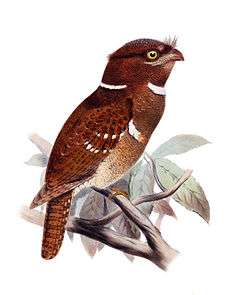Philippine frogmouth
The Philippine frogmouth (Batrachostomus septimus) is a nocturnal bird that is found throughout the Philippine archipelago. It is common in lowland forests and maturing second growth. Little information is known about the bird. It feeds on grasshoppers, cicadas, crickets and beetles.
| Philippine frogmouth | |
|---|---|
 | |
| Scientific classification | |
| Kingdom: | Animalia |
| Phylum: | Chordata |
| Class: | Aves |
| Order: | Caprimulgiformes |
| Family: | Podargidae |
| Genus: | Batrachostomus |
| Species: | B. septimus |
| Binomial name | |
| Batrachostomus septimus Tweeddale, 1877 | |
Description
Like all frogmouths, the Philippine frogmouth has large eyes to allow better night vision, a large flat bill they use to capture insects, and cryptic plumage that allows them to be camouflaged while perched during the day. They are the only frogmouth found in the Philippines; the only species they could be confused with is the Philippine Nightjar, which has a similar shape, but very different plumage.
The Philippine frogmouth is a medium frogmouth, 24–26 cm long, with two color morphs (and intermediate phases); one is a chestnut rufous with deep rufous ground color, the other a lighter brown with buff and black barring.[2] Both morphs have 3 distinct light buff or white bands; one on their hindneck, a second on their lower throat, and a third around the lower breast. They have a yellow-orange iris and brown feet and bill. Males and females are similar, though females are typically darker and plainer than males.[3]
Distribution and Habitat
The Philippine frogmouth is a sedentary bird, endemic to the Philippines, and is widely distributed within the archipelago, though noticeably absent from Palawan. Though rare, there have been sightings in India and Australia. They are thought to be found in lowland and maturing (but not mature) second growth forests, but their habitat is not known in detail as they are only active at night and do not sing songs or have loud calls.[4][3]
Behavior and Ecology
Reproduction
The nest is built from a horizontal branch that is placed two to five meters above ground. It is made from the parent's own downy feathers which is held in place using spider silk, moss and lichens. The female lays one egg per season. The male incubates the egg during the day and the female at night.
Diet and Feeding
Philippine frogmouths are adaptable, and eat large insects, such as grasshoppers, cicadas, crickets, and beetles. They feed by waiting on low branches and striking when they notice an insect moving below.[4] Like other species in the genus Batrachostomus, the Philippine frogmouth has elongated bristles around the base of their bill, believed to protect their eyes from prey.[5]
Vocalizations
Male calls are a series of low, deep woah, wash, Guam, or g-aw noises, or a short even trill.[3] Female calls are louder, a short mewl that descends in pitch. Both sexes have a harsh growling call they repeat several times per minute, and a harsh staccato-like scream that is believed to be an alarm call.[6]
Conservation
The Philippine frogmouth is currently listed as species of least concern by the IUCN as of 2012, though it is believed its population is slowly declining due to habitat destruction. The reason for this listing is the large range, the rate of decline not reaching the threshold to qualify as a vulnerable species, and while the population size has not been officially quantified, it is believed to exceed the threshold to be considered vulnerable based on the population size criterion.[7]
References
- BirdLife International (2012). "Batrachostomus septimus". IUCN Red List of Threatened Species. 2012. Retrieved 26 November 2013.CS1 maint: ref=harv (link)
- "Philippine Frogmouth (Batrachostomus septimus) – Planet of Birds". www.planetofbirds.com. Archived from the original on 2018-03-14. Retrieved 2018-03-13.
- Nigel, Cleere (2010-08-30). Nightjars : a guide to nightjars and related birds. Nurney, David. London. ISBN 978-1408135471. OCLC 727647954.
- Heaney, Lawrence (11 May 2004). "Philippine Deforestation". The Field Museum. Archived from the original on 15 March 2006. Retrieved 11 March 2018.
- Firefly encyclopedia of birds. Perrins, Christopher M. Buffalo, N.Y.: Firefly Books. 2003. ISBN 1552977773. OCLC 51922852.CS1 maint: others (link)
- A guide to the birds of the Philippines. Kennedy, Robert S. Oxford: Oxford University Press. 2000. ISBN 0198546688. OCLC 43936896.CS1 maint: others (link)
- "Batrachostomus septimus (Philippine Frogmouth)". IUCN Red List of Threatened Species. Retrieved 2018-03-13.
